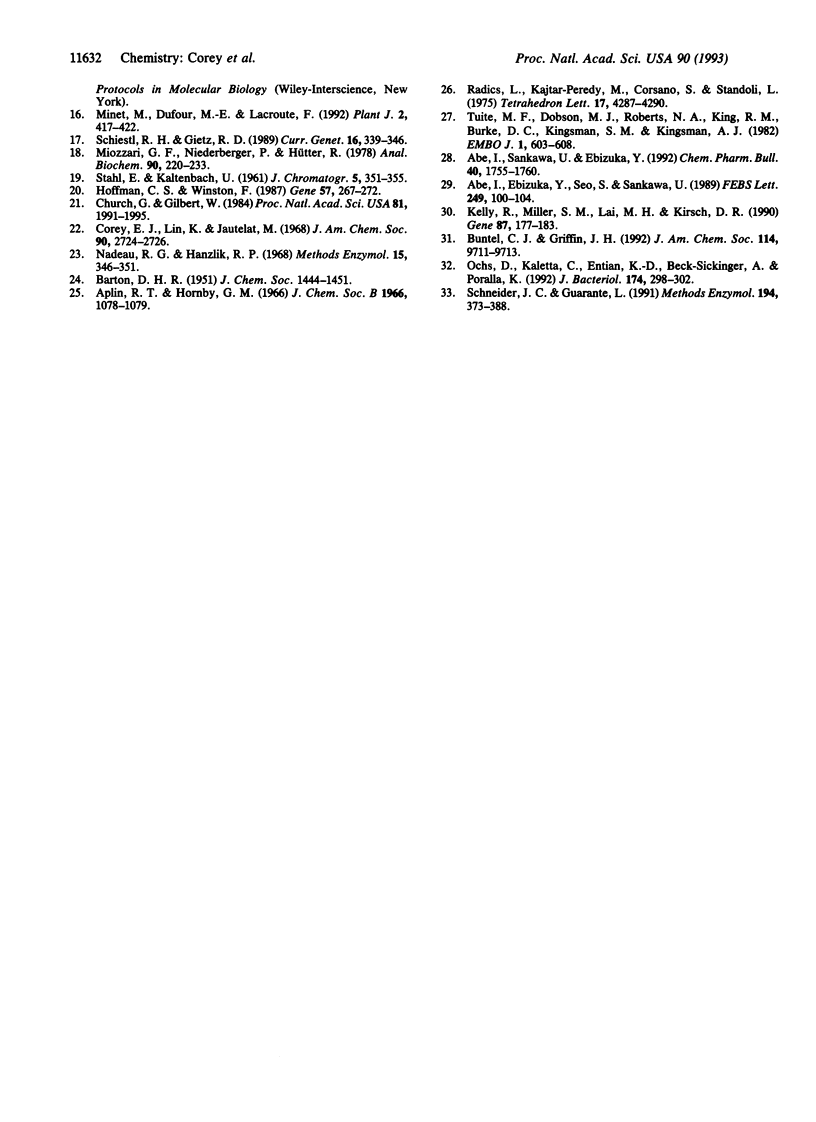Abstract
Whereas vertebrates and fungi synthesize sterols from epoxysqualene through the intermediate lanosterol, plants cyclize epoxysqualene to cycloartenol as the initial sterol. We report the cloning and characterization of CAS1, an Arabidopsis thaliana gene encoding cycloartenol synthase [(S)-2,3-epoxysqualene mutase (cyclizing, cycloartenol forming), EC 5.4.99.8]. A yeast mutant lacking lanosterol synthase [(S)-2,3-epoxysqualene mutase (cyclizing, lanosterol forming), EC 5.4.99.7] was transformed with an A. thaliana cDNA yeast expression library, and colonies were assayed for epoxysqualene mutase activity by thin-layer chromatography. One out of approximately 10,000 transformants produced a homogenate that cyclized 2,3-epoxysqualene to the plant sterol cycloartenol. This activity was shown to be plasmid dependent. The plasmid insert contains a 2277-bp open reading frame capable of encoding an 86-kDa protein with significant homology to lanosterol synthase from Candida albicans and squalene-hopene cyclase (EC 5.4.99.-) from Bacillus acidocalcarius. The method used to clone this gene should be generally applicable to genes responsible for secondary metabolite biosynthesis.
Full text
PDF




Selected References
These references are in PubMed. This may not be the complete list of references from this article.
- Church G. M., Gilbert W. Genomic sequencing. Proc Natl Acad Sci U S A. 1984 Apr;81(7):1991–1995. doi: 10.1073/pnas.81.7.1991. [DOI] [PMC free article] [PubMed] [Google Scholar]
- Cory E. J., Russey W. E., Ortiz de Montellano P. R. 2,3-oxidosqualene, an intermediate in the biological synthesis of sterols from squalene. J Am Chem Soc. 1966 Oct 20;88(20):4750–4751. doi: 10.1021/ja00972a056. [DOI] [PubMed] [Google Scholar]
- Dean P. D., Ortiz de Montellano P. R., Bloch K., Corey E. J. A soluble 2,3-oxidosqualene sterol cyclase. J Biol Chem. 1967 Jun 25;242(12):3014–3015. [PubMed] [Google Scholar]
- Gollub E. G., Liu K. P., Dayan J., Adlersberg M., Sprinson D. B. Yeast mutants deficient in heme biosynthesis and a heme mutant additionally blocked in cyclization of 2,3-oxidosqualene. J Biol Chem. 1977 May 10;252(9):2846–2854. [PubMed] [Google Scholar]
- Harrison D. M. The biosynthesis of triterpenoids and steroids. Nat Prod Rep. 1985 Dec;2(6):525–560. doi: 10.1039/np9850200525. [DOI] [PubMed] [Google Scholar]
- Harrison D. M. The biosynthesis of triterpenoids, steroids, and carotenoids. Nat Prod Rep. 1988 Aug;5(4):387–415. doi: 10.1039/np9880500387. [DOI] [PubMed] [Google Scholar]
- Harrison D. M. The biosynthesis of triterpenoids, steroids, and carotenoids. Nat Prod Rep. 1990 Dec;7(6):459–484. doi: 10.1039/np9900700459. [DOI] [PubMed] [Google Scholar]
- Hoffman C. S., Winston F. A ten-minute DNA preparation from yeast efficiently releases autonomous plasmids for transformation of Escherichia coli. Gene. 1987;57(2-3):267–272. doi: 10.1016/0378-1119(87)90131-4. [DOI] [PubMed] [Google Scholar]
- Kelly R., Miller S. M., Lai M. H., Kirsch D. R. Cloning and characterization of the 2,3-oxidosqualene cyclase-coding gene of Candida albicans. Gene. 1990 Mar 15;87(2):177–183. doi: 10.1016/0378-1119(90)90299-7. [DOI] [PubMed] [Google Scholar]
- Minet M., Dufour M. E., Lacroute F. Complementation of Saccharomyces cerevisiae auxotrophic mutants by Arabidopsis thaliana cDNAs. Plant J. 1992 May;2(3):417–422. doi: 10.1111/j.1365-313x.1992.00417.x. [DOI] [PubMed] [Google Scholar]
- Miozzari G. F., Niederberger P., Hütter R. Permeabilization of microorganisms by Triton X-100. Anal Biochem. 1978 Oct 1;90(1):220–233. doi: 10.1016/0003-2697(78)90026-x. [DOI] [PubMed] [Google Scholar]
- Ochs D., Kaletta C., Entian K. D., Beck-Sickinger A., Poralla K. Cloning, expression, and sequencing of squalene-hopene cyclase, a key enzyme in triterpenoid metabolism. J Bacteriol. 1992 Jan;174(1):298–302. doi: 10.1128/jb.174.1.298-302.1992. [DOI] [PMC free article] [PubMed] [Google Scholar]
- Rees H. H., Goad L. J., Goodwin T. W. 2,3-oxidosqualene cycloartenol cyclase from Ochromonas malhamensis. Biochim Biophys Acta. 1969 Jun 10;176(4):892–894. [PubMed] [Google Scholar]
- Rees H. H., Goad L. J., Goodwin T. W. Cyclization of 2,3-oxidosqualene to cycloartenol in a cell-free system from higher plants. Tetrahedron Lett. 1968 Feb;6:723–725. doi: 10.1016/s0040-4039(00)75620-6. [DOI] [PubMed] [Google Scholar]
- Schiestl R. H., Gietz R. D. High efficiency transformation of intact yeast cells using single stranded nucleic acids as a carrier. Curr Genet. 1989 Dec;16(5-6):339–346. doi: 10.1007/BF00340712. [DOI] [PubMed] [Google Scholar]
- Schneider J. C., Guarente L. Vectors for expression of cloned genes in yeast: regulation, overproduction, and underproduction. Methods Enzymol. 1991;194:373–388. doi: 10.1016/0076-6879(91)94028-b. [DOI] [PubMed] [Google Scholar]
- Sikorski R. S., Hieter P. A system of shuttle vectors and yeast host strains designed for efficient manipulation of DNA in Saccharomyces cerevisiae. Genetics. 1989 May;122(1):19–27. doi: 10.1093/genetics/122.1.19. [DOI] [PMC free article] [PubMed] [Google Scholar]
- Tuite M. F., Dobson M. J., Roberts N. A., King R. M., Burke D. C., Kingsman S. M., Kingsman A. J. Regulated high efficiency expression of human interferon-alpha in Saccharomyces cerevisiae. EMBO J. 1982;1(5):603–608. doi: 10.1002/j.1460-2075.1982.tb01215.x. [DOI] [PMC free article] [PubMed] [Google Scholar]


